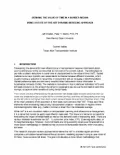-
Past ETC Papers

Browse, search and view papers from the past AET Conferences.
-
Members' Area

AET promotes networking and exchange of ideas, information and opportunities amongst members.
Conference Papers 2017
Barcelona, Spain
ETC Conference Papers 2017
Deriving the Value of Time in a Border Region Using a State-of-the-Art Dynamic Modeling Approach
Seminar
Day 3 (6 Oct 2017), Session 7, Value of Time, 09:30 - 11:00
Status
Accepted, documents submitted
Submitted by / Abstract owner
Jeffrey Shelton
Authors
Jeff Shelton, New Mexico State University, Gabriel Valdez, Texas A&M Transportation Institute, Peter T. Martin, New Mexico State University
Short abstract
Researchers developed a simulation-based DTA model where the VoT was varied until output flow rates match actual field data collected. Results were compared to six different mathematical approaches used to derive the VoT in the region.
Abstract
There is much literature about the theory and practice of traffic and toll revenue forecasting but surprisingly little attention has been paid to the predictive accuracy of those forecasts. One important component in those forecasts is the value of time (VoT). While the VoT is a very important notion in transportation planning and infrastructure investment, it is a value that cannot be easily measured or quantified into a finite numerical value. In addition, the Texas-Mexico border region has lower socio-demographic factors in terms of economic income than other major urban areas in Texas. This poses a barrier to successfully forecast the impact of toll roads as well as the demand for it. There are various methods to estimate the VoT, however, a more robust method is needed to help improve the forecasted reliability when evaluating toll lanes, high occupancy toll (HOT) lanes, high occupancy vehicle (HOV) lanes or managed lane applications.
In this research, various methodologies are applied and compared to a state-of-the-art dynamic modeling approach that uses real world toll revenue and traffic data. Six different mathematical approaches for the City of El Paso, Texas were calculated—each method deriving a different VoT for passenger cars. A simulation-based dynamic traffic assignment (DTA) model was then developed and calibrated for the same geographic region. The DTA modeled approach uses various VoT values where output flow rates on a toll road are compared to field data collected by the Camino Real Regional Mobility Authority (toll authority). After multiple iterations of simulation, a VoT value that corresponds to the actual number of vehicles using the tolled facility was obtained. Model results were compared to the six mathematical methodologies. The final VoT from the simulation model fell lower than most of the mathematical calculations. This is indicative of the lower socio-demographics in the region and more importantly—validates the low toll road usage and subsequent shortfall of revenue.
The DTA modeling approach is a validation of actual driver behavior governed by a perceived VoT because it shows the willingness of driver’s to pay a toll. Any increases in toll road prices can now be quickly calculated with the validated model results. In addition, planning agencies will now have a more robust approach to calculate travel forecasts and predicted toll revenue with higher accuracy.
Documents:

Association For
European Transport
Forester House
Doctors Lane
Henley-in-Arden
Warwickshire, UK
B95 5AW
+44 (0) 15 64 793552
VAT number: 710 1866 64
Conference Supporters & Endorsers




Legal Entity
The Association for European Transport is registered as an Association ('vereniging') with the Chamber of Commerce for Haaglanden in The Netherlands under company number 27170096.
Built on Zenario




